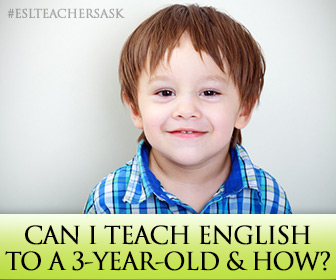Although tremendously rewarding, teaching English to children ages 3 to 5 can be a daunting task.
These little learners are full of energy and enthusiasm, which you may put to good use, but to keep them interested and motivated, classes have to be fun. You must also keep in mind that there are language learning goals that need to be met – after all, they’re not enrolled in classes to merely have fun. They need to start learning English.
So, to better target English classes to children under 5, the first thing you should consider is your young learners' characteristics. According to Piaget’s theory of cognitive development, children 3 to 5 would still be in the pre-operational cognitive stage.
As an ESL teacher you need to understand that children at this stage essentially:
- Present an egocentric intuitive intelligence– it’s hard for them to see the viewpoint of others - and there is no logical thought
- Are capable of symbolic thought, which means they can mentally represent the world around them through words, images, and symbols, i.e., “cat” can be any cat and not just theirs
- Attribute life and thinking to inanimate objects, i.e., clouds cry because they are sad
- Are able to classify objects, i.e., all the blue blocks, all the animals, all of the large toys vs. the small ones, etc.
- Cannot grasp abstract concepts, but only concrete objects or physical situations
- Are able to engage in make believe
- Have memory skills
- Use imagination
- Are able to understand the difference between past and future, although they can't grasp the concept of time expressed in days, weeks, months, years
The biggest development for children at this stage is language, accompanied by a great deal of sensorimotor activity.
So, what does all of this mean to you as an ESL teacher?
It is obvious that since children at this stage can’t read or write, most of the English language learning will have to be imparted through sensorimotor activities, games, stories, and videos just to name a few. Children under 5 also have a very short attention span, which means you may have to switch activities every 5 minutes or so.
So, in the ESL classroom for very young learners, you should keep in mind the following essentials:
- You need to have tons of toys and realia to use in games and activities. This includes, cars, planes and all types of transport, animals, tea sets and cooking utensils, plastic fruits and vegetables, as well as flashcards of varying sizes.
- Repetition is key. Greet them every day with the same song, or greeting till they naturally say it back. It doesn’t matter if you spend an entire class hour only asking questions with “Do you like…?”, as long as they spontaneously answer, “Yes, I do”, or “No, I don’t”. See more on repetition and drilling here: “How to Drill: Drilling Activities for Your English Classroom”.
- It will get VERY physical. You’ll need to jump, hop, move your arms, and clap your hands, which means you’ll end up exhausted, but oh, so exhilarated. See more on Total Physical Response activities in our article ‘TPR Tricks: 5 Fabulous Ways to Use Total Physical Response in the ESL Classroom’.
- Make sure videos are short. Remember they have short attention spans. Make the viewing short, but to the point, making it thus more effective. Ask them to count how many birds, children, or fruits they see in the video. Ask them to raise their hands as soon as they see a zebra, lion or any other animal.
- Act out role plays with puppets. Children enjoy them, and it's a very effective way to teach ways to answer a question or replies to greetings.
- Music and singing are highly effective, but especially if they are accompanied by movement. Songs like “Head, Shoulders, Knees and Toes”, or “This Is the Way We…” accompanied by actions are great ways to teach vocabulary or verbs.
- Keep it fast paced and engaging. Switch from one activity to another and use fillers if needed.
- Arts and crafts and mini-projects are wonderful ways to teach vocabulary, seasonal activities and holidays.
- Don’t worry about what they can’t do (read or write). Focus on what they CAN DO and make use of their abilities. Most under 5s can count to ten, so board games with dice are great for the ESL classroom.
Keep in mind that children at this stage understand more than they are able to produce verbally.
They may not say a whole lot in English, particularly 3-year olds, but that doesn’t mean they are not learning. Their flexible little brains are taking it all in, and soon enough they’ll be spouting off some greetings and short answers right back at you.
Above all, give them a chance to be fully immersed in the English language. Speak to them in English all the time, and illustrate what you wish them to do if they don't understand. Those of us who have taught little ones will readily attest to the fact that they are blessed with a unique ability to accept the new language with nothing but natural curiosity and openness. If they watch a video in English or listen to a song, they won’t very likely demand a translation, unlike their adult counterparts. Which makes them more often than not an absolute pleasure to teach.
Do you have any experience teaching English to this particular age group? Please share with us!

